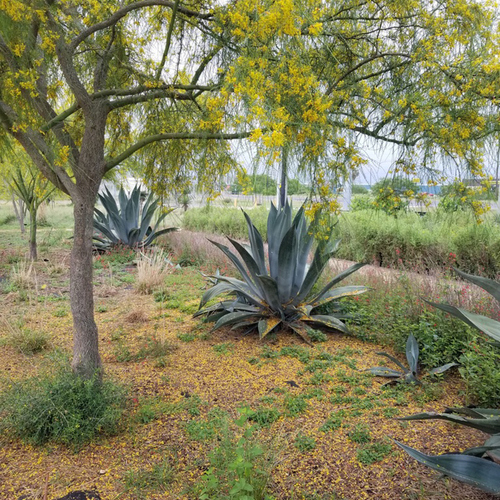
Happy Friday GPODers!
We’re wrapping up our week of diverse garden spaces with Lisa Adam in Texas. Lisa lives very close to the southernmost point of Texas, and shared photos of her garden in Weslaco last fall (Check out that post here: Lisa’s Wildlife Haven Near the Southernmost Point of Texas), but today she’s sharing a recent visit to a really cool ecotourism center that highlights and educates on the the ecosystems native to this unique region.
My name is Lisa Adam and I live in Weslaco, Texas. (I previously submitted photos from my retirement cottage.) Today, I’m taking readers to the South Texas Ecotourism Center (STEC). Located in Laguna Vista, Texas, STEC is on route to the popular beach destination, South Padre Island. STEC promotes exploration of the region’s nature through gardens, interpretive exhibits and sculpture, bird blinds, and a boardwalk overlook. Today I’ll focus on some of its iconic plants. It’s zone 10 in this region, so excuse the cloudy skies, which we appreciate as a relief from the sun.
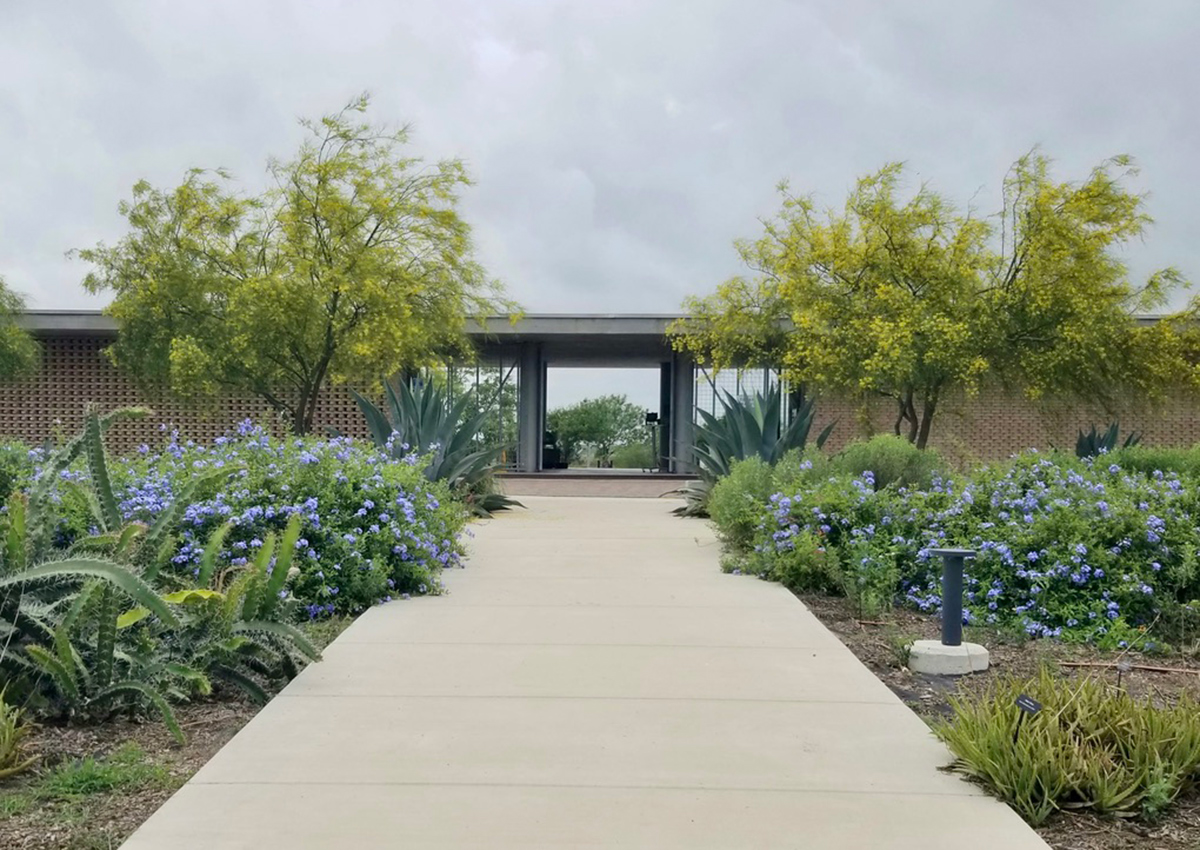 The low-slung STEC building is a modern take on the traditional dog-trot, with an open passageway between two wings. In front of the building is a modernistic garden featuring deep rows of massed plants, mostly native. Visible in the photo are rows of yellow-blooming retama tree (Parkinsonia aculeata, Zones 8–11), century plant (Agave americana, Zones 8–10), non-native blue plumbago (Plumbago auriculata, Zones 9–11), triangle cactus (Acanthocereus tetragonus, Zones 9–11), and non-native aloe vera.
The low-slung STEC building is a modern take on the traditional dog-trot, with an open passageway between two wings. In front of the building is a modernistic garden featuring deep rows of massed plants, mostly native. Visible in the photo are rows of yellow-blooming retama tree (Parkinsonia aculeata, Zones 8–11), century plant (Agave americana, Zones 8–10), non-native blue plumbago (Plumbago auriculata, Zones 9–11), triangle cactus (Acanthocereus tetragonus, Zones 9–11), and non-native aloe vera.
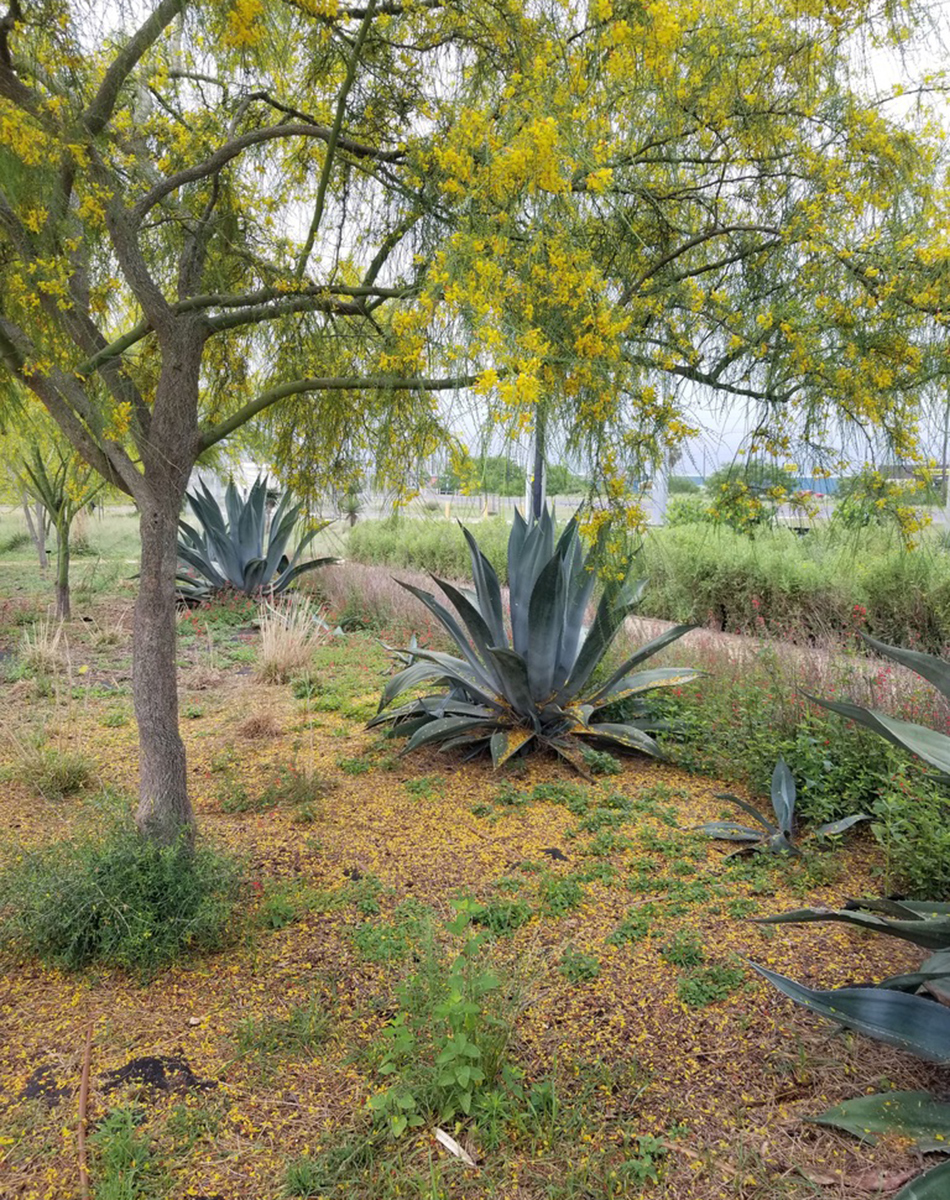 Another view of the retama and century plants.
Another view of the retama and century plants.
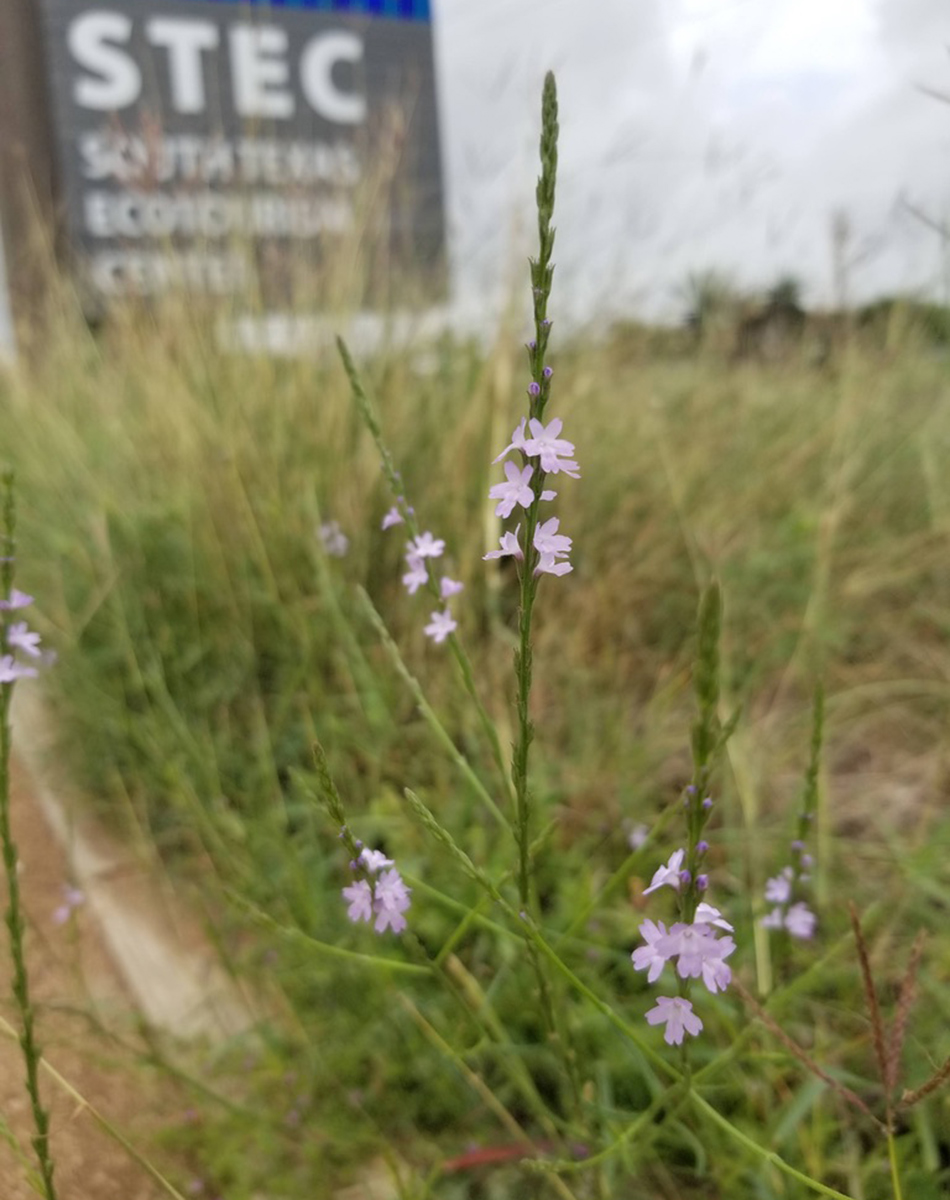 Deep rows of tough native grasses line the heat-radiating road frontage. Here, a delicate Texas vervain (Verbena halei, Zones 7–10) stands out against the grass.
Deep rows of tough native grasses line the heat-radiating road frontage. Here, a delicate Texas vervain (Verbena halei, Zones 7–10) stands out against the grass.
Past the open passage of the building, visitors walk through multiple garden areas that model several different ecosystems of the region: thorn forest, savanna, and coastal prairie. Beyond those is a boardwalk that looks out over Bahia Grande, Texas’ largest wetland restoration project and part of the Laguna Atascosa National Wildlife Refuge.
Cacti feature prominently at STEC since they grow in nearly every eco-region in South Texas.
 Tasajillo (Cylindropuntia leptocaulis, Zones 9–11) is a shrub-like cactus. It’s also called Christmas cholla or Christmas cactus, because the red fruit sometimes persist until the holiday season if they are not all eaten by birds.
Tasajillo (Cylindropuntia leptocaulis, Zones 9–11) is a shrub-like cactus. It’s also called Christmas cholla or Christmas cactus, because the red fruit sometimes persist until the holiday season if they are not all eaten by birds.
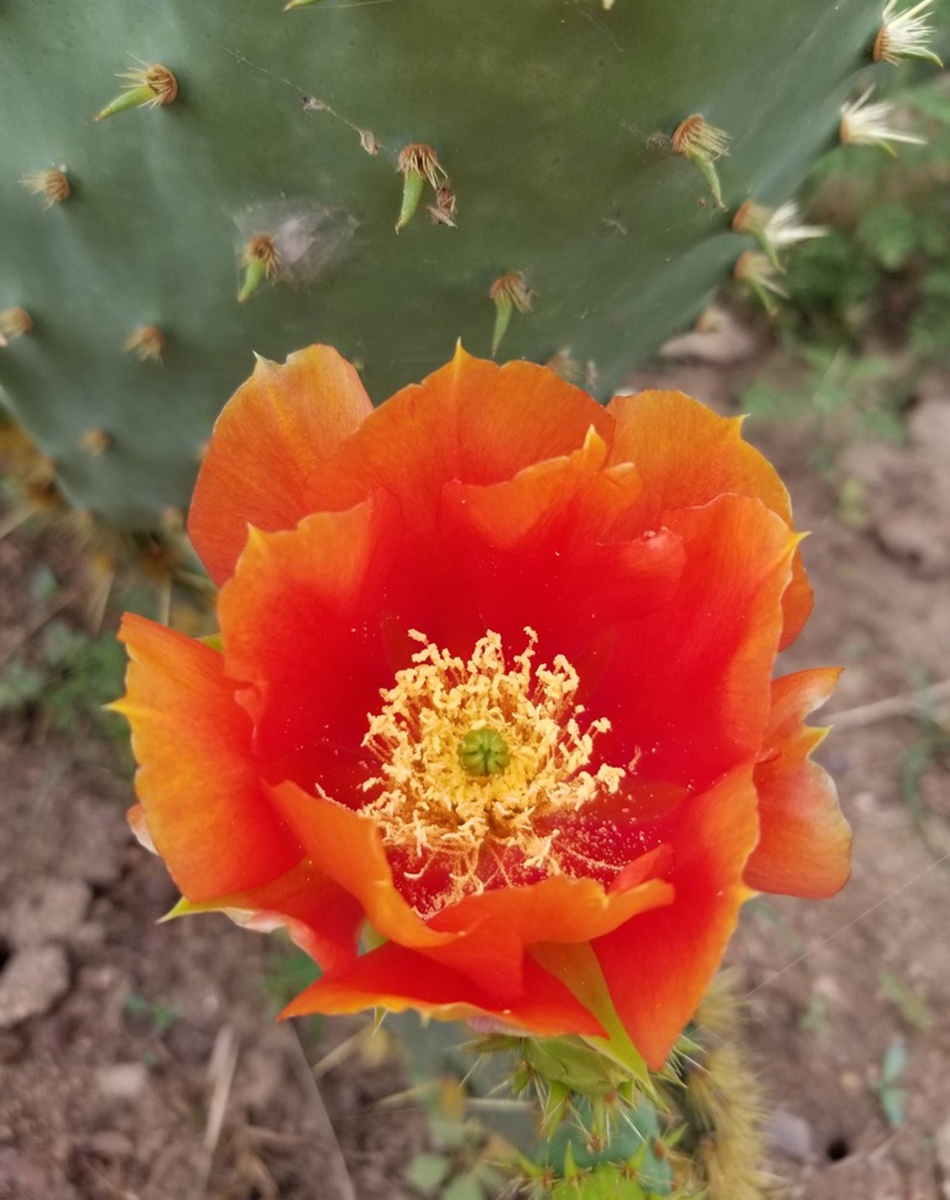 Texas prickly pear cacti (Opuntia lindheimeri, Zones 8–11) usually bloom in yellow, but occasionally in orange or red. Their wide-open blossoms give easy access to nectar and pollen for native bees.
Texas prickly pear cacti (Opuntia lindheimeri, Zones 8–11) usually bloom in yellow, but occasionally in orange or red. Their wide-open blossoms give easy access to nectar and pollen for native bees.
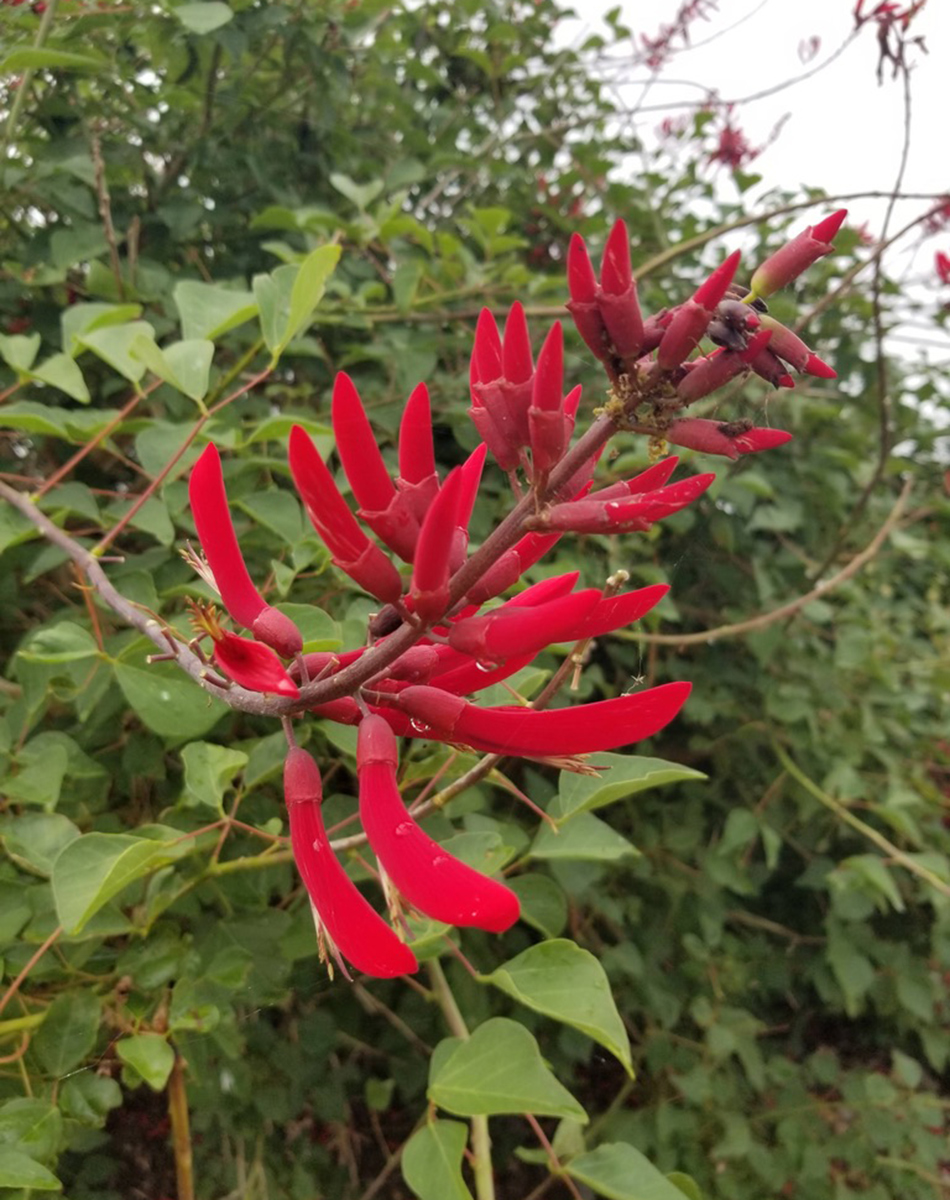 Coral bean (Erythrina herbacea, Zones 8–11) is a tall shrub, not a cactus, but it is also thorny, as well as poisonous! But its fantastic blooms make it a hummingbird magnet and a desirable ornamental in the area.
Coral bean (Erythrina herbacea, Zones 8–11) is a tall shrub, not a cactus, but it is also thorny, as well as poisonous! But its fantastic blooms make it a hummingbird magnet and a desirable ornamental in the area.
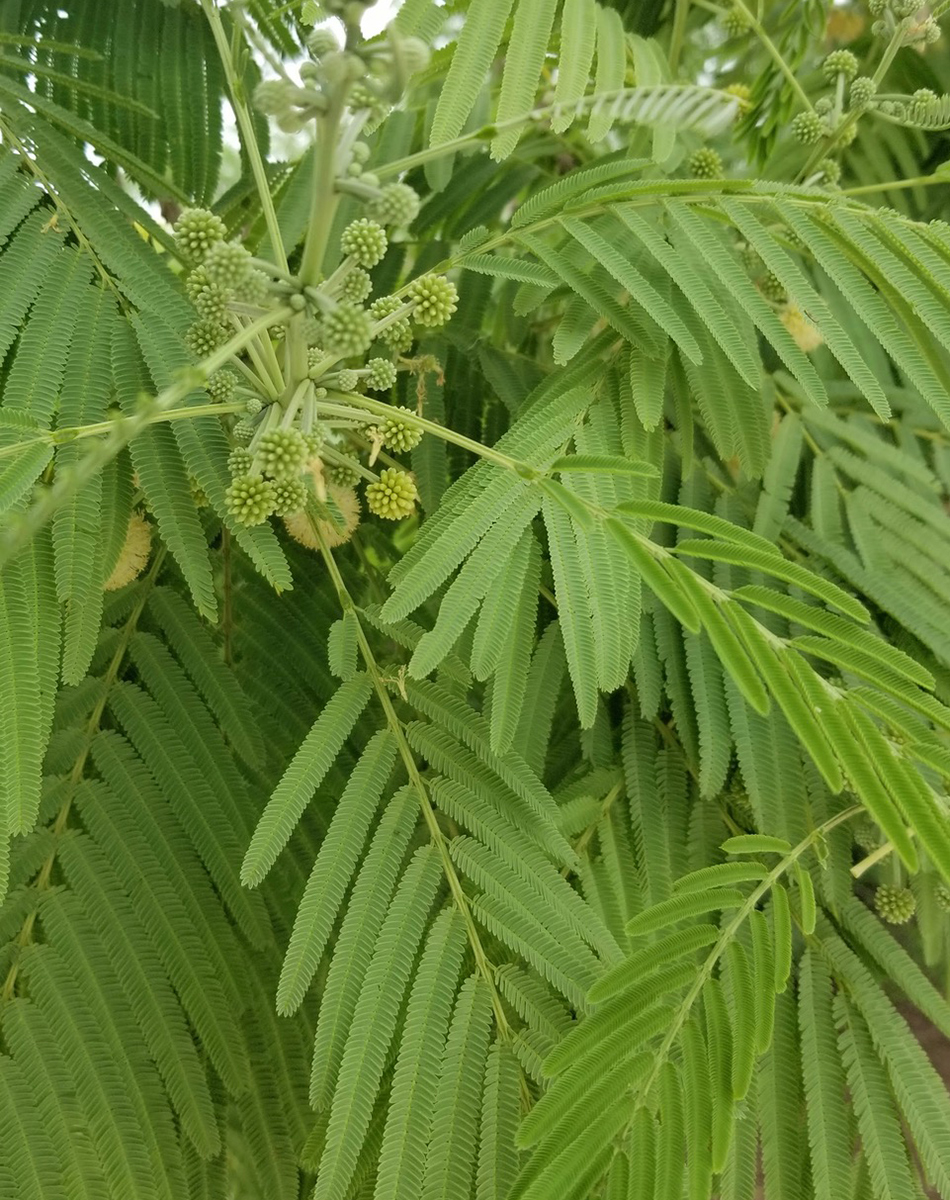 These nubby buds on the tepeguaje, or lead tree (Leucaena pulverulenta, Zones 8–11), will turn into creamy-yellow puffballs in a few days. Locally, tepeguaje is considered a good “nurse tree.” The trees grows fast, and their intricately compounded leaves provide much-needed shade for younger or smaller plants below them.
These nubby buds on the tepeguaje, or lead tree (Leucaena pulverulenta, Zones 8–11), will turn into creamy-yellow puffballs in a few days. Locally, tepeguaje is considered a good “nurse tree.” The trees grows fast, and their intricately compounded leaves provide much-needed shade for younger or smaller plants below them.
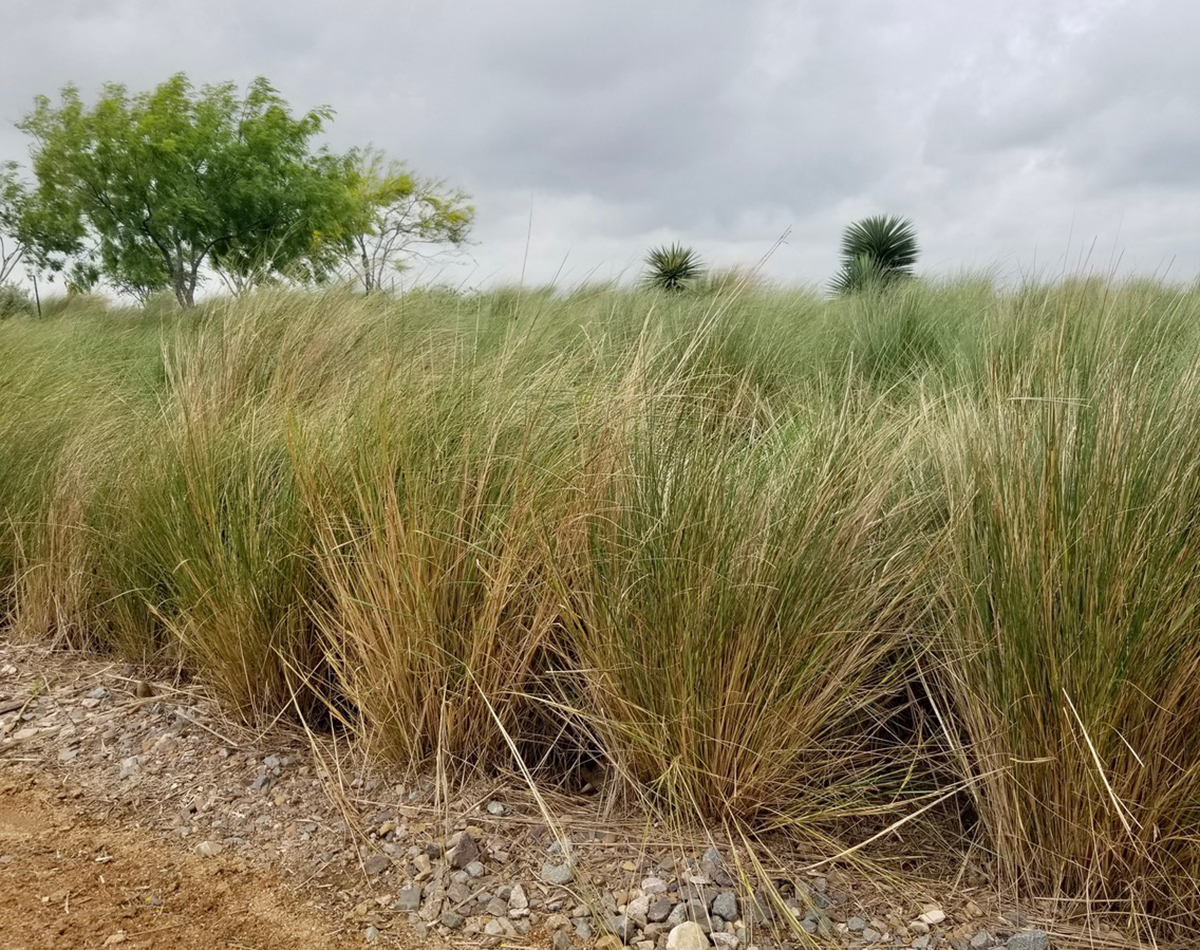 I believe the grass in this photo is Gulf cordgrass (Sporobolus spartinae, Zones 8–11). The neatly bermed edge makes clear this is a cultivated space. Behind the grass are honey mesquite trees (Prosopis glandulosa, Zones 7–11) and Spanish dagger (Yucca treculeana, Zones 7–10).
I believe the grass in this photo is Gulf cordgrass (Sporobolus spartinae, Zones 8–11). The neatly bermed edge makes clear this is a cultivated space. Behind the grass are honey mesquite trees (Prosopis glandulosa, Zones 7–11) and Spanish dagger (Yucca treculeana, Zones 7–10).
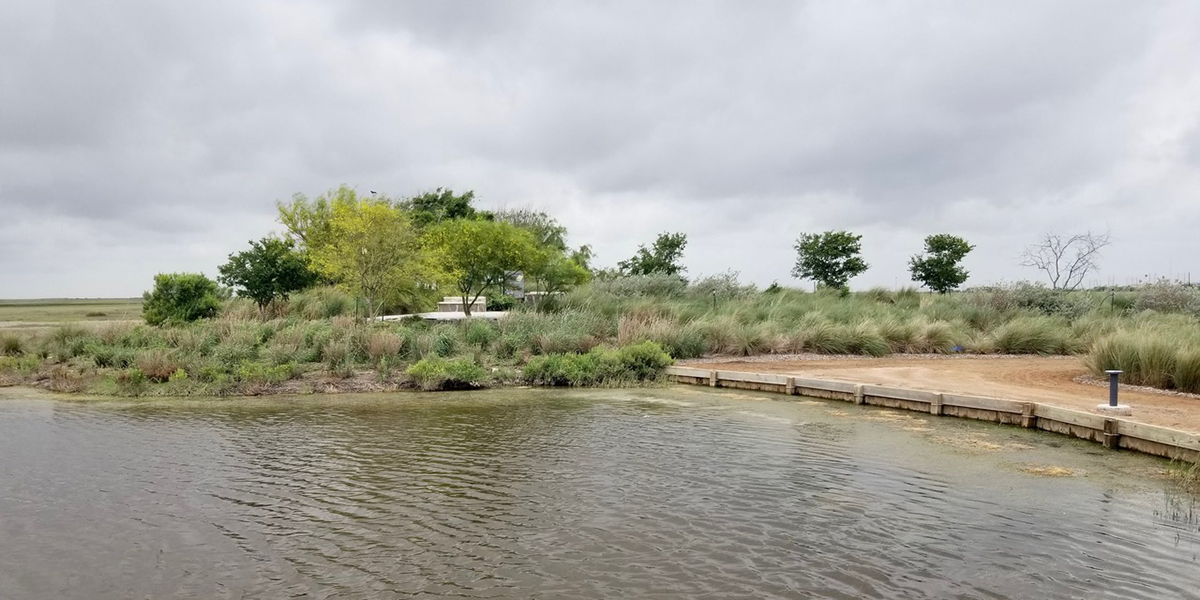 An artificial peninsula by a pond mimics the area’s lomas, which are ancient clay dunes covered with grass and scrubland. At far left in the photo, you can glimpse the coastal wetlands of Bahia Grande in the distance. Their restoration has reduced dust-caused asthma in the region, boosted the region’s fishing and shrimping industry, and provided much needed habitat for endangered species.
An artificial peninsula by a pond mimics the area’s lomas, which are ancient clay dunes covered with grass and scrubland. At far left in the photo, you can glimpse the coastal wetlands of Bahia Grande in the distance. Their restoration has reduced dust-caused asthma in the region, boosted the region’s fishing and shrimping industry, and provided much needed habitat for endangered species.
Thank you so much for sharing this incredible plant destination with us, Lisa! I can’t think of a better place to give us an insight into the incredible plant palette of your region, and your selection of highlights was a delight.
Have you visited any public gardens this season? Last week I made a trip to New York Botanic Garden that I will be sharing highlights from in the coming weeks, but I would love to see where you’ve enjoyed some special spring displays. Follow the directions below to submit photos via email, or send me a DM on Instagram: @agirlherdogandtheroad.
We want to see YOUR garden!
Have photos to share? We’d love to see your garden, a particular collection of plants you love, or a wonderful garden you had the chance to visit!
To submit, send 5–10 photos to [email protected] along with some information about the plants in the pictures and where you took the photos. We’d love to hear where you are located, how long you’ve been gardening, successes you are proud of, failures you learned from, hopes for the future, favorite plants, or funny stories from your garden.
Have a mobile phone? Tag your photos on Facebook, Instagram or Twitter with #FineGardening!
Do you receive the GPOD by email yet? Sign up here
Fine Gardening Recommended Products

Lee Valley Mini Garden Shear Set
Fine Gardening receives a commission for items purchased through links on this site, including Amazon Associates and other affiliate advertising programs.
These shears have a distinctive finger rest that not only aids grip but allows greater freedom of movement than a conventional handle design. They have a durable powder-coat finish to resist rust and wear, and a simple clasp that locks the spring-action stainless-steel blades closed. The set includes one pair of round-nose shears measuring 5 1/2″ overall with 1″ blades for cutting stems up to 3/8″ in diameter, and one pair of 6 1/2″ needle-nose shears with 2″ fine-tip blades for precise work.
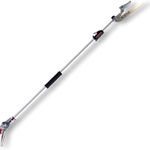
ARS Telescoping Long Reach Pruner
Fine Gardening receives a commission for items purchased through links on this site, including Amazon Associates and other affiliate advertising programs.
Telescopes from 4 to 7′. Cut and Hold (160) Blades. Drop forged blades for unsurpassed long lasting sharpness. Lightweight, 2.3 lbs., for continued use. Perfectly balanced for easy pruning.
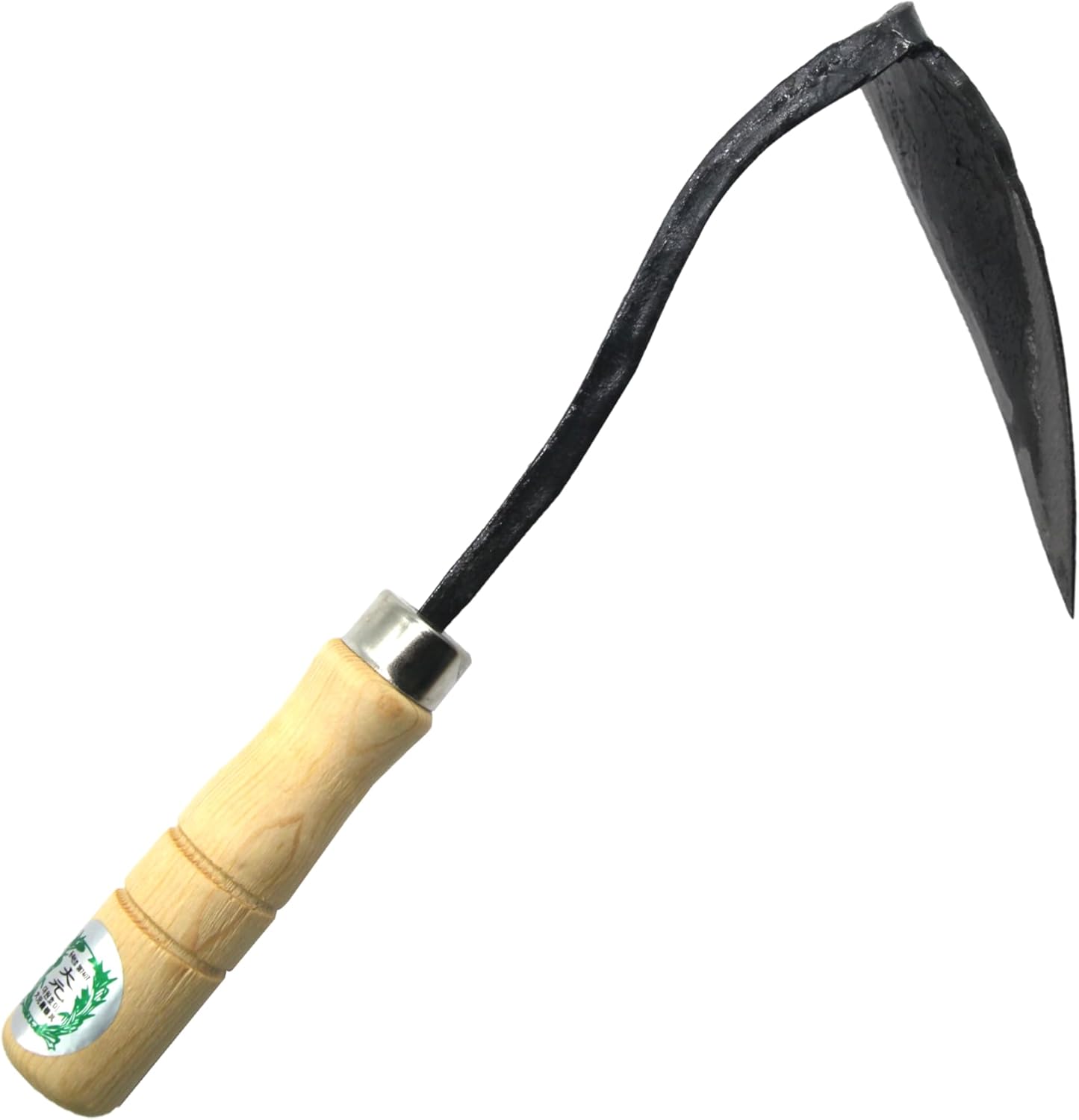
Ho-Mi Digger – Korean Triangle Blade
Fine Gardening receives a commission for items purchased through links on this site, including Amazon Associates and other affiliate advertising programs.
Versatile Tool: The Easy Digger Korean Triangle Blade Ho Mi Ho-mi is a versatile gardening tool designed for leveling and digging in home and garden settings. Efficient Design: Its unique triangular blade shape allows for easy soil penetration and efficient leveling of garden beds or landscaping areas. Durable Construction: Crafted with sturdy materials, this tool ensures long-lasting performance and reliability.
Ergonomic Handle: The comfortable handle provides a secure grip, reducing hand fatigue during extended use. Compact Size: Its compact design makes it easy to maneuver in tight spaces and store when not in use.








